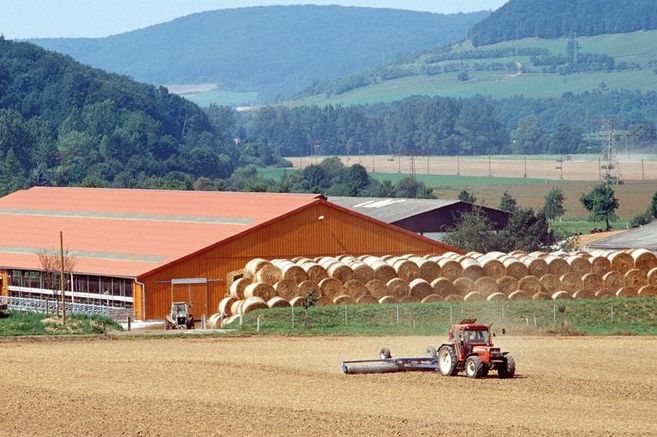Project
Further development of the Thünen model network - Farm models

Further development of the Thünen model network - Farm models
EU agricultural policies as well as international trade policies have changed considerably during the last decades. This has led to an increased demand from policy makers and scientists for model-based quantitative assessments of the consequences of respective policy reforms.
Background and Objective
The related complex analyses require the interactive application of models for different decision levels (micro, meso and macro level). The Thünen model network connects and further develops farm, regional and sector partial and general equilibrium models for the joint application for policy impact assessments. The further development of the model network is of central importance in order to continually and promptly carry out quantitative assessments of the policy impacts while ensuring high scientific quality.
Approach
The models of the network are closely linked to other research carried out at the institute as well as to national and international networks. Projects in the institute result in new model approaches for the network and the models of the network support the success of other institute research projects. The resources of the model network are supplemented by third party funding, which are used to study relevant future topics and developments and enable the model network to commence time intensive model developments early. We continuously update the model data bases and fine-tune the co-ordination between models, e.g. through the establishment of a common baseline.
Data and Methods
The Thünen-Institute of Farm Economics maintains the models TIPI-CAL and TYPICROP of the agri benchmark network, as well as FARMIS.
FARMIS is a mathematical programming model for farm groups which is based on information from the national farm accountancy data network.
Data from typical farms of the agri benchmark network provide the basis for farm-level analyses with the production and accounting models TIPI-CAL and TYPICROP.
Preliminary Results
The current version of FARMIS is based on a three-year average of farm accountancy data for the period 2009/10 to 2011/12. Within the DFG-research group SIAG we are currently improving the modelling of structural change in agriculture. A first application on dairy market reform scenarios highlights the diverging impacts these may have on the developments of the number of dairy farms of different size or regions, and their income and output (Offermann and Margarian, 2014). At present, model development focuses on a more differentiated representation of adjustments of production intensity and technology to changing framework conditions.
In 2014 and 2015, the currently existing different model technologies of the agri benchmark network (Excel, Access, JSON) will be merged to a single online data collection tool (data model). The calculations will in future be implemented in GAMS (process model) to benefit from synergies with FARMIS and other model applications within the institute. The approach will be extended by incorporating data on the environment (nutrients, energy, water, greenhouse gas emissions), farm households and animal welfare. We also intend to enlarge the network to other countries, particularly to developing countries and emerging economies.
Thünen-Contact

Involved Thünen-Partners
Duration
Permanent task 12.1995
More Information
Project status:
ongoing
Publications to the project
- 0
Haß M, Banse M, Deblitz C, Freund F, Geibel I, Gocht A, Kreins P, Laquai V, Offermann F, Osterburg B, Pelikan J, Rieger J, Rösemann C, Salamon P, Zinnbauer M, Zirngibl M-E (2020) Thünen-Baseline 2020 - 2030: Agrarökonomische Projektionen für Deutschland. Braunschweig: Johann Heinrich von Thünen-Institut, 146 p, Thünen Rep 82, DOI:10.3220/REP1601889632000
- 1
Hecht J, Moakes S, Offermann F (2016) Redistribution of direct payments to permanent grassland: intended and unintended impact. EuroChoices 15(3):25-32, DOI:10.1111/1746-692X.12099
- 2
Deppermann A, Grethe H, Offermann F (2014) Distributional effects of CAP liberalisation on western German farm incomes: an ex-ante analysis. Eur Rev Agric Econ 41(4):605-626, DOI:10.1093/erae/jbt034
- 3
Offermann F, Margarian A (2014) Modelling structural change in Ex-Ante-Policy Impact Analysis. In: Zopounidis C, Kalogeras N, Mattas K, Dijk G, Baourakis G (eds) Agricultural cooperative management and policy : new robust, reliable and coherent tools. Cham: Springer International Publ, pp 151-162, DOI:10.1007/978-3-319-06635-6_8
- 4
Offermann F, Deblitz C, Golla B, Gömann H, Haenel H-D, Kleinhanß W, Kreins P, Ledebur O von, Osterburg B, Pelikan J, Röder N, Rösemann C, Salamon P, Sanders J, Witte T de (2014) Thünen-Baseline 2013-2023: Agrarökonomische Projektionen für Deutschland. Braunschweig: Johann Heinrich von Thünen-Institut, 112 p, Thünen Rep 19, DOI:10.3220/REP_19_2014
- 5
Gocht A, Albrecht R, Ehrmann M, Gömann H, Kleinhanß W, Klepper R, Ledebur O von, Offermann F, Osterburg B, Rothe A, Schroeder LA, Wendt H (2013) Gefährdet die vorgeschlagene Zuckermarktreform den Produktionsstandort Deutschland - eine modellgestützte Analyse. In: Bahrs E, Becker T, Birner R, Brockmeier M, Dabbert S, Doluschitz R, Grethe H, Lippert C, Thiele E (eds) Herausforderungen des globalen Wandels für Agrarentwicklung und Welternährung : 52. Jahrestagung der Gesellschaft für Wirtschafts- und Sozialwissenschaften des Landbaues e. V. vom 26. bis 28. September 2012. Münster ; München: Landwirtschaftsverl ; BLV-Verlagsges, pp 309-320
- 6
Offermann F, de Frahan BH, Brunke H, De Blander R (2012) Ex-ante evaluations of public policies using farm models based on econometrically estimated flexible cost functions. In: Ecomod 2012 : International conference on economic modelling ; Seville, Spain July 4 - 6, 2012. Sevilla: University of Sevilla, pp 1-10
- 7
Offermann F, Banse M, Ehrmann M, Gocht A, Gömann H, Haenel H-D, Kleinhanß W, Kreins P, Ledebur O von, Osterburg B, Pelikan J, Rösemann C, Salamon P, Sanders J (2012) vTI-Baseline 2011-2021: agrarökonomische Projektionen für Deutschland. Braunschweig: vTI, 82 p, Landbauforsch SH 355
- 8
Offermann F, Banse M, Ehrmann M, Gocht A, Gömann H, Haenel H-D, Kleinhanß W, Kreins P, Ledebur O von, Osterburg B, Pelikan J, Rösemann C, Salamon P, Sanders J (2012) vTI-Baseline 2011-2021: Agri-economic projections for Germany. Braunschweig: vTI, VI, 78 p, Landbauforsch SH 358
- 9
Offermann F, Gömann H, Kleinhanß W, Kreins P, Ledebur O von, Osterburg B, Pelikan J, Salamon P, Sanders J (2010) vTI-Baseline 2009 - 2019: Agrarökonomische Projektionen für Deutschland. Braunschweig: vTI, 88 p, Landbauforsch SH 333
- 10
Offermann F, Brockmeier M, Gömann H, Kleinhanß W, Kreins P, Ledebur O von, Osterburg B, Pelikan J, Salamon P (2009) vTI-Baseline 2008. Braunschweig: vTI, 50 p, Landbauforsch SH 325
- 11
Offermann F (2008) Key issues of linking models for policy impact assessment in agriculture. Agrarwirtschaft 57(8):361-362
- 12
Offermann F, Kleinhanß W, Hüttel S, Küpker B (2005) Assessing the 2003 CAP reform impacts on German Agriculture using the farm group model FARMIS. In: Arfini F (ed) Modelling agricultural policies: state of the art and new challenges : proceedings of the 89th European Seminar of the European Association of Agricultural Economists (EAAE), Parma, Italy, February 3-5, 2005. Parma: Monte Universita Parma Editore, pp 546-564



![[Translate to English:] Logo des Bundesministerium für Ernährung und Landwirtschaft](/media/allgemein/logos/BMEL_Logo.svg)